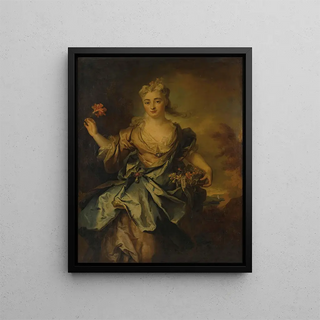Art print | Portrait of a lady - Nicolas de Largillière


View from behind

Frame (optional)
Portrait of a Lady - Nicolas de Largillière – Captivating Introduction
In the fascinating world of art, some works transcend time and continue to captivate minds many centuries after their creation. "Portrait of a Lady" by Nicolas de Largillière is one of these masterpieces. This artwork, created in the 18th century, embodies not only the refined aesthetics of its era but also the psychological depth that characterizes the portrait. The depicted lady, whose gaze seems to tell a story, invites the viewer to delve into a universe where beauty and introspection meet. Contemplating this piece, one feels an immediate connection with the past, as if each brushstroke was carefully thought out to convey a lasting emotion.
Style and uniqueness of the work
Nicolas de Largillière's style is distinguished by his ability to combine realism and idealization. In "Portrait of a Lady," the treatment of colors and textures is particularly remarkable. The drapery of the dress, meticulously rendered, almost seems to come alive under the light, while the lady's face is imbued with a softness that evokes a certain melancholy. Largillière excels in capturing not only the external appearance but also the very essence of his subjects. The minute details, such as shimmering jewelry or reflections in the eyes, add an extra dimension to this artwork. Every element is carefully orchestrated to create a visual harmony that inevitably draws the eye. This portrait does not merely depict a figure; it tells a story, that of an era when social conventions and personal aspirations intertwined in a complex ballet.
The artist and his influence
Nicolas de Largillière, an emblematic figure of 18th-century French painting, established himself as one of the most influential portraitists of his time. Trained in the ateliers of great masters, he quickly developed a style that was uniquely his own, blending technical finesse with artistic sensitivity. His work is not limited to simple representation but engages in a dialogue with the artistic currents of his era, while foreshadowing future evolutions. Largillière captured the spirit of his time, painting not only aristocrats

Matte finish

View from behind

Frame (optional)
Portrait of a Lady - Nicolas de Largillière – Captivating Introduction
In the fascinating world of art, some works transcend time and continue to captivate minds many centuries after their creation. "Portrait of a Lady" by Nicolas de Largillière is one of these masterpieces. This artwork, created in the 18th century, embodies not only the refined aesthetics of its era but also the psychological depth that characterizes the portrait. The depicted lady, whose gaze seems to tell a story, invites the viewer to delve into a universe where beauty and introspection meet. Contemplating this piece, one feels an immediate connection with the past, as if each brushstroke was carefully thought out to convey a lasting emotion.
Style and uniqueness of the work
Nicolas de Largillière's style is distinguished by his ability to combine realism and idealization. In "Portrait of a Lady," the treatment of colors and textures is particularly remarkable. The drapery of the dress, meticulously rendered, almost seems to come alive under the light, while the lady's face is imbued with a softness that evokes a certain melancholy. Largillière excels in capturing not only the external appearance but also the very essence of his subjects. The minute details, such as shimmering jewelry or reflections in the eyes, add an extra dimension to this artwork. Every element is carefully orchestrated to create a visual harmony that inevitably draws the eye. This portrait does not merely depict a figure; it tells a story, that of an era when social conventions and personal aspirations intertwined in a complex ballet.
The artist and his influence
Nicolas de Largillière, an emblematic figure of 18th-century French painting, established himself as one of the most influential portraitists of his time. Trained in the ateliers of great masters, he quickly developed a style that was uniquely his own, blending technical finesse with artistic sensitivity. His work is not limited to simple representation but engages in a dialogue with the artistic currents of his era, while foreshadowing future evolutions. Largillière captured the spirit of his time, painting not only aristocrats






